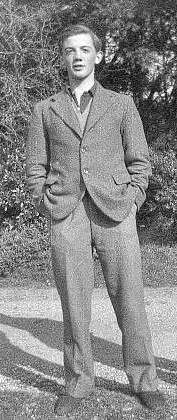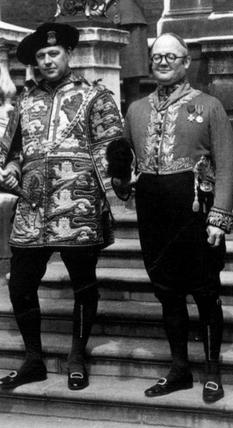John Brooke-Little facts for kids
John Philip Brooke Brooke-Little (born April 6, 1927 – died February 13, 2006) was an English writer who knew a lot about heraldry. Heraldry is the study of coats of arms and badges. He also worked for a long time as a herald at the College of Arms in London. Heralds are experts who help create and record coats of arms.
In 1947, when he was still a student, Brooke-Little started a group called the Society of Heraldic Antiquaries. This group is now known as The Heraldry Society and is one of the most important groups for studying heraldry. He was the chairman of this society for 50 years. Then, from 1997 until he passed away in 2006, he was its president.
Besides starting this group, Brooke-Little was part of other heraldry groups. He worked for many years as an officer of arms. He started as a Bluemantle Pursuivant, which is a junior role. He then rose to become Clarenceux King of Arms, which is the second highest heraldic job in England.
Contents
Early Life and Family
John Brooke-Little was born in Blackheath, Kent. His mother, Constance Egan, wrote many children's stories. These included the Epaminondas books and the adventures of Jummy the Baby Elephant. In the 1920s, his mother was an editor for a magazine called Home Chat. This experience helped her later when she edited the Heraldry Society's journal, the Coat of Arms, in the 1950s.
John's father, Raymond Brooke-Little, was an electrical engineer. John went to Clayesmore School, which was a special kind of public school in Dorset. This school was very important to him. He later sent his own children there. He also helped the school get its own coat of arms. He was in charge of the school's board of governors from 1971 to 1983.
When John was a boy, he first visited the College of Arms. He met Sir Algar Howard, who was the head of the heralds there. Sir Algar encouraged John's growing interest in heraldry. While still a student, John started a heraldry society with his friends.
In 1949, Brooke-Little went to New College at the University of Oxford. He studied history there. One of his college friends was Colin Cole, who later became the Garter King of Arms. Together, they restarted the Oxford University Heraldry Society.
Brooke-Little married Mary Pierce in 1960. They had three sons, Philip, Leo, and Merlin, and one daughter, Clare. After he retired from the College of Arms in 2004, he lived in Oxfordshire with the families of his sons, Leo and Merlin.
In 1994, Brooke-Little had a major stroke. This made it harder for him to move and speak, but his mind was still very sharp. He kept working as a herald for three more years until he retired. He also continued to guide the Heraldry Society. He had more small strokes over the years. He could still go to Heraldry Society events, but arthritis made it hard for him to move around. He passed away on February 13, 2006, in Banbury, Oxfordshire, at age 78, after a series of these small strokes. He was one of the last heralds who had worked at the Coronation of Queen Elizabeth II.
Working as a Herald
In 1952 and 1953, Brooke-Little helped plan the Coronation of Queen Elizabeth II. He was a special officer for the Coronation and played a key role in organizing the event. His strong interest in heraldry led to his first job as a herald. He joined the College of Arms as Bluemantle Pursuivant in 1956. A pursuivant is the lowest rank for an officer of arms.
Brooke-Little once shared the story of how he got this job. In 1956, the Garter King of Arms, Sir George Bellew, suggested Brooke-Little and Colin Cole for the Bluemantle position. They both met with the Earl Marshal, who was in charge. The Earl Marshal usually only had one candidate. He offered the job to Colin Cole first, but Cole turned it down because his wife was expecting a baby. So, Brooke-Little became Bluemantle.
In 1967, Brooke-Little was promoted to Richmond Herald. On July 7, 1980, after almost 30 years of service, he became Norroy and Ulster King of Arms. This meant he was in charge of heraldry in the northern part of England and in Northern Ireland. He believed that as the Ulster King of Arms, he was still an officer of the Order of St Patrick, even though the last knight of that order had died in 1974.
Brooke-Little remained interested in Irish heraldry even after he was promoted. When the head of the National Library of Ireland became the Chief Herald of Ireland, Brooke-Little wrote to The Daily Telegraph. He stressed how important it was to keep strong traditions of heraldry and family history in the Irish Office of Arms.
In 1992, when Colin Cole retired as Garter King of Arms, Brooke-Little was a top choice to replace him. This is the highest heraldic job in England. However, because of his friendly and social lifestyle, Brooke-Little was not seen as the best fit for the management duties of the Garter office. So, Sir Conrad Swan got the job instead.
On June 19, 1995, Brooke-Little became Clarenceux King of Arms after Sir Anthony Wagner passed away. This is the senior of the two "provincial" Kings of Arms. The person in this role is in charge of heraldry in England and Wales south of the River Trent. Heralds used to be appointed for life. However, a rule was made that they had to retire at age 70. Brooke-Little became Clarenceux just after this rule started, so he only served for two years. He ended his heraldic career without ever becoming Garter King of Arms or being made a knight.
Besides his main duties, Brooke-Little also held three important jobs at the College of Arms. From 1974 to 1982, he was the registrar. This meant he was responsible for writing down all new coats of arms in the college's records. You can find his signature on the official documents for every coat of arms granted during that time. He was also the college's librarian from 1974 to 1994 and the treasurer from 1978 to 1995. He also directed the Heralds' Museum at the Tower of London from 1991 to 1997. This museum is no longer open.
Brooke-Little was well-known as a professional herald and writer. However, his biggest contribution to heraldry was probably starting the Heraldry Society. He also guided the society and edited its journal for many years.
Other Heraldic Work
His Own Coat of Arms
In 1952, as John Brooke-Little was starting his career in heraldry, he looked into his own family's coat of arms. His family had been using a certain coat of arms, but he found out they didn't actually have the right to use it. So, John worked to get a new coat of arms for his father.
When asked for ideas, his father suggested that unicorns would be a good symbol. Red droplets, called gouttes, on the shield were a nod to his family's old land in Slaughterford. These arms were officially given to Raymond Brooke-Little on March 5, 1952. John then combined these arms with those of his mother, Constance Egan.
The full description of his shield of arms is quite detailed. It includes unicorns' heads and two gold dolphins. His crest, which sits above the shield, features a black unicorn. He was also given the motto Recte Aut Nil, which means 'correctly or not at all'. He also had a special badge, which was a gold triquetra (a three-cornered knot) with a silver ring through it.
The Heraldry Society
In 1947, when he was 20 years old, Brooke-Little started the Society of Heraldic Antiquaries. This group was renamed The Heraldry Society in 1950. It became an official charity in 1956. The main goal of the society is to help more people learn about heraldry, genealogy (the study of family history), and related topics.
Brooke-Little was the chairman of this society for 50 years. In 1997, as he was finishing his career as an officer of arms, he became the society's president. He stayed in this role until he passed away. Brooke-Little also edited the society's scholarly journal, the Coat of Arms. His mother, Constance Egan, was the managing editor of the journal until 1965, but Brooke-Little always had a big influence on it. In 2005, he finally handed over full control of the journal to two younger heralds.
The White Lion Society
Brooke-Little was very important in starting the White Lion Society. In 1984, someone suggested to Brooke-Little that it would be good to create a "Society of Friends" for the College of Arms. Brooke-Little remembered that another herald, Wilfrid Scott-Giles, had suggested the same idea before. He had even proposed the name 'White Lion Society'. This name comes from the two white lions that support the College of Arms' own coat of arms. These lions represent the House of Mowbray, a family whose arms the Earl Marshal inherited.
Brooke-Little presented the idea to the College of Arms, and they approved it. The White Lion Society officially started in 1986.
Awards and Recognitions
Brooke-Little received many awards for his service to the Crown. He was made a 4th Class Member of the Royal Victorian Order in 1969. This award is given for special service to the British Royal Family. He received it for his work at the Investiture of the Prince of Wales. He was later promoted to Commander of the Royal Victorian Order in 1984.
Even though most Kings of Arms were knighted, he never received that honour. The closest he came was in 1975 when he was made a Knight of Justice of the Most Venerable Order of the Hospital of Saint John of Jerusalem. This is a British version of the ancient Knights Hospitaller.
Brooke-Little was also an Honorary Fellow of the Institute of Heraldic and Genealogical Studies. He was a Chevalier of the Order of the Fleur de Lys. He led the Scriveners' Company from 1985 to 1986 and was chairman of the Harleian Society. He was also president of the English Language Literary Trust for eleven years. His work in heraldry also led him to be a trustee of the Royal Air Force Heraldry Trust. He was an adviser on heraldry to the National Trust from 1983 until his death.
Besides his British honours, Brooke-Little also served as Chancellor of the British Association of the Sovereign Military Order of Malta from 1973 to 1977. He received several honours from this order, including Knight Grand Cross of Grace and Devotion. He also received the Order of Merito Melitense in 1964. He was also made a Knight Grand Cross of Grace of the Sacred Military Constantinian Order of Saint George. He also held the Cruz Distinguida (1st class) de San Raimundo de Penafort.
Books He Wrote or Edited
Brooke-Little wrote or edited at least ten books, including:
- Boutell's Heraldry (he edited the editions from 1963 to 1983)
- Royal Arms
- Royal London (1953)
- The University City of Oxford (1955)
- Knights of the Middle Ages (1966)
- An Heraldic Alphabet (1973)
- Beasts in Heraldry (1974)
- The British Monarchy in Colour (1976)
- Royal Heraldry: Beasts and Badges of Britain (1977)
- Royal Ceremonies of State (1980)
- Fox Davies' Complete Guide to Heraldry (a revised edition)




